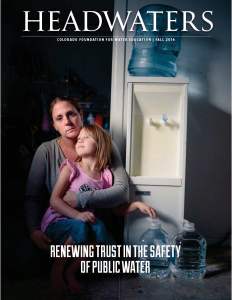
Photo Credit: Jonas BergstenThere is a high likelihood that at some point in your life, you have used a product containing fluoride. Many of us have memories of fluoride treatments at the dentist’s office—either in the form of a goopy gel oozing out of ill-fitting trays or as a liquid rinse. Even as adults, most people brush their teeth twice a day with toothpaste containing fluoride; all in the interest of keeping their teeth in tip-top shape.But, did you know that there is a good chance that fluoride is also present in your tap water?
Almost all water has naturally-occurring fluoride. Fluoride is a mineral—like Vitamin D or calcium—that is released from rocks into our air, soil and water; however, depending on the source of the water, fluoride is not always present in concentrations that would be optimal for preventing tooth decay. It is also possible for levels of fluoride to be too high, which is why water providers test fluoride levels in tap water, allowing them to make adjustments based on current levels.
Fluoride research began in 1901, in Colorado Springs. Initial research was conducted by dental school graduate Fredrick McKay, and in 1909, he was joined by dental researcher, Dr. G.V. Black. Upon arriving in Colorado Springs, McKay noticed that Colorado Springs natives had brown-stained teeth. Having never seen this type of tooth stain before, McKay asked Black to join him so that together, they could determine the source of “Colorado Brown Stain.”
What they discovered was a connection between fluoride in water and dental health. In Colorado Springs, the cause of stained teeth in locals turned out to be dental fluorosis, a cosmetic result of excessive fluoride consumption due to high levels of fluoride in the local water.
According to WebMD, dental fluorosis is caused by overexposure to fluoride—sources include water, toothpaste, mouthwash, etc.—during the first eight years of life, when permanent teeth are being formed. Discoloration can range from lacy white markings to yellow or brown stains and may include surface irregularities, including severe pitting. McKay and Black determined that the high levels of fluoride not only caused the staining, but also provided an unusually high resistance to tooth decay.
In 1931, the first fluoride studies were conducted by Dr. H. Trendley Dean. Based on previous research done in the field, he hypothesized that it was possible to have fluoride levels in water that were low enough to be safe for consumption and avoid dental fluorosis, yet high enough to help prevent tooth decay.
In 1945, his hypothesis was put to the test in Grand Rapids, Michigan; the first city in the world to fluoridate its drinking water. Over the course of 15 years, 30,000 school children were monitored for tooth decay. After 11 years, the caries rate (the rate of tooth decay) was down 60 percent. The study results indicated that tooth decay could be preventable.
 Dean’s study spurred a national movement to add fluoride to community water systems and more than 70 years later, the majority of the U.S. population is receiving fluoridated water. According to the Center for Disease Control and Prevention (CDC), in 2014, 66.3 percent of the total U.S. population and 74.4 percent of the population receiving water from a community water system were receiving fluoridated water. 74 percent of Colorado residents are receiving fluoridated water, falling in line with the rest of the country.
Dean’s study spurred a national movement to add fluoride to community water systems and more than 70 years later, the majority of the U.S. population is receiving fluoridated water. According to the Center for Disease Control and Prevention (CDC), in 2014, 66.3 percent of the total U.S. population and 74.4 percent of the population receiving water from a community water system were receiving fluoridated water. 74 percent of Colorado residents are receiving fluoridated water, falling in line with the rest of the country.
Many people receive fluoridated water, but wonder if it’s safe to consume. Everyone has the right to know what they are ingesting and how it will impact their health—check on the fluoridation status of the water that you are receiving at My Water’s Fluoride. Learn about other contaminants that may naturally occur in your water, or additives like fluoride, and how your water provider addresses them by finding your local Consumer Confidence Report on the Colorado Water Quality Control Division’s website here.
Some people are opposed to the addition of fluoride to public drinking water. Opponents of fluoride in drinking water are troubled by the Food and Drug Administration’s (FDA) classification of fluoride as a drug for safety testing purposes. They see the addition of fluoride to water as being for the sole purpose of preventing tooth decay, as opposed to improving water quality, making it a medical treatment that is being imposed on them without consent.Another concern includes the inability of an individual consumer to regulate their fluoride dosage. Opponents worry that someone who drinks more water than someone else may receive a higher dosage of fluoride. In this vein, the dosage in a single glass is the same across the board, regardless of the needs of the person ingesting fluoride.
In 2013, Portland, Oregon voters rejected a ballot proposal to add fluoride to their drinking water, making it the largest U.S. city without fluoride in their water, or plans to add it. Opponents of the measure echo the belief that fluoride as a chemical will ruin the city’s pristine water supply, and that adding fluoride violates an individual’s right to consent to medication. From a USA Today article:

Photo Credit: The.Rohit
“I don’t want chemicals in my water,” Sarah Lazzaro said after voting Tuesday. “I know that there are really no known health risks with it, but there’s a lot of things we find out later in life really do have health risks.”
During the summer of 2015, both Snowmass, Colorado and Denver Water debated the practice of adding fluoride to their public water systems. Initially, the Snowmass Water and Sanitation District decided to discontinue adding fluoride to their water; however, in October 2015, under public pressure, the board reversed their decision, and will not discontinue the procedure. Denver Water also found themselves at the center of the fluoride debate, and while they have reduced the dosage of fluoride, per the recommendation of the U.S. Public Health Service, they too, continue to add fluoride to the water they provide. Many who disagree with fluoride being added to drinking water stand firm in their position, keeping the conversation flowing between them and those who view it as beneficial.
The U.S. Public Health Service recommends a fluoride concentration of 0.7 mg/L, or 0.7 parts per million (ppm), to maintain the benefits of reducing the risk of tooth decay, while also decreasing the possibility of dental fluorosis. The U.S. Environmental Protection Association regulates fluoride contamination in drinking water with an enforceable Maximum Contaminant Level (MCL) of 4 mg/L, or 4 ppm and an unenforceable secondary standard set at 2 mg/L. Other agencies including the CDC, the American Academy of Pediatrics (AAP), the American Dental Association (ADA), the American Public Health Association (APHA), the World Health Organization (WHO) and other major health organizations in the United States, believe that community water fluoridation, in recommended low quantities, is safe.
Having clean, safe, drinking water is important to the health of individuals and the environment. Knowing what is in your water and how policy maker decisions can affect public health is the first step in making decisions that will have a positive impact on your personal well-being.
 Read more about water and its connection to public health in the latest issue of Headwaters magazine, “Renewing Trust in the Safety of Public Water”.
Read more about water and its connection to public health in the latest issue of Headwaters magazine, “Renewing Trust in the Safety of Public Water”.
Not a Headwaters subscriber? Sign up here, or visit yourwatercolorado.org for the digital version. Headwaters is the flagship publication of the Colorado Foundation for Water Education and covers current events, trends and opportunities in Colorado water.

 Print
Print
Reblogged this on Coyote Gulch.
i do not did know that there is a good chance that fluoride is also present in my tap water? thanks for highlight the information.